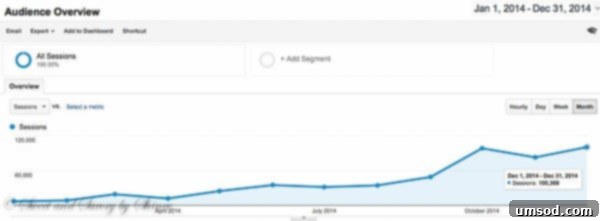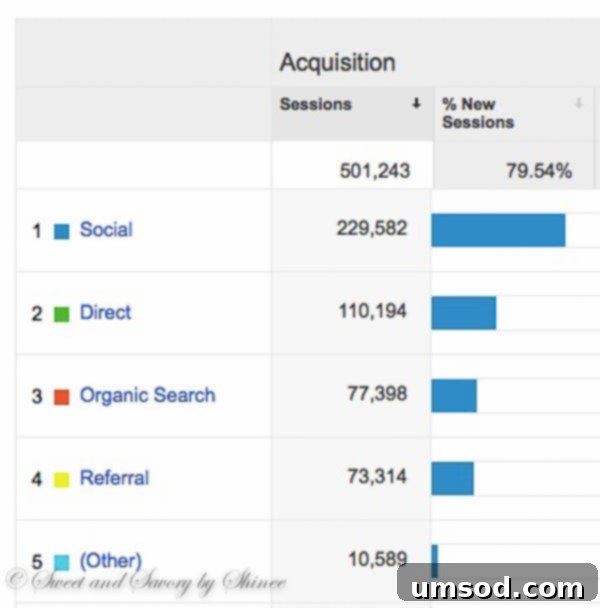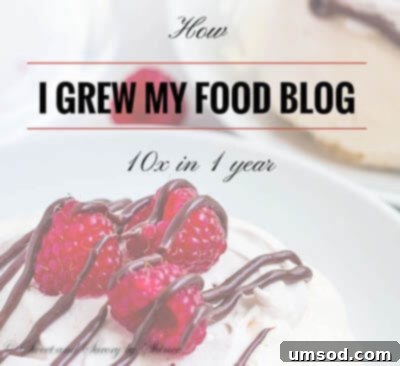Are you passionate about food? Do you love creating delicious recipes, capturing stunning photos, and sharing your culinary adventures with the world? If you’re a food blogger, chances are you pour your heart and soul into every post, hoping to connect with a wide audience. Yet, the reality often hits hard: you publish an incredible recipe, complete with mouth-watering images and engaging text, only to find your hard work met with silence. It’s a common frustration, and one I understand deeply, having walked that very path myself.

Many years ago, I embarked on my serious blogging journey. Like many, I started with enthusiasm but little direction. For an entire year, my efforts yielded minimal results. But then, I decided to shift gears, focusing on strategic growth rather than just sporadic posting. The transformation was remarkable. In just one year, from January to December, I witnessed my monthly page views skyrocket tenfold – from a modest 10,000 to an astounding 100,000+. This wasn’t a stroke of luck or a get-rich-quick scheme; it was the result of consistent effort, strategic planning, and a deep commitment to learning. Today, I’m thrilled to share the exact actionable steps I took to achieve this significant milestone, strategies you can start implementing right away to cultivate a thriving food blog.
Initially, I wasn’t even aware what constituted “high traffic.” My focus was simply on continuous improvement and consistent growth, month over month. It was only later, when popular ad networks required a minimum of 80-100K page views for eligibility, that I realized I had surpassed an important benchmark. This journey isn’t shared to boast, but to give back to the vibrant blogging community that has supported me. I learned immensely from other generous bloggers, and now it’s my turn to contribute my findings. So, grab a cup of coffee, because we’re about to dive deep into the world of strategic food blogging.

My primary goal for that pivotal year was clear: to build a dedicated readership and significantly increase traffic to my blog. I didn’t fixate on a specific number, but rather on seeing a continuous upward trend. Here are the precise steps that propelled my blog from obscurity to a flourishing platform:
Consistent Content for Engaged Readers: Make a Posting Schedule
One of the first and most critical changes I implemented was establishing a consistent posting schedule. Before this, my blog was a sporadic affair – a flurry of posts one month, followed by weeks of silence. This erratic pattern was a significant barrier to growth. To attract and retain readers, consistency is paramount. I settled on a Monday, Wednesday, Friday schedule, which felt achievable and sustainable for me. The key is to find a rhythm that works for you. Don’t feel pressured to publish daily; even one high-quality post a week is far better than inconsistent bursts of content. Many bloggers juggle full-time jobs, family responsibilities, and other commitments. Design a schedule that aligns with your lifestyle and capacity.
A well-defined posting schedule serves multiple purposes: it holds you accountable, ensuring you regularly create new content, and it sets clear expectations for your audience. Your readers will know when to anticipate fresh recipes and stories, fostering loyalty and encouraging repeat visits. Moreover, search engines favor websites that consistently publish new, relevant content, which can positively impact your search rankings over time. Consider using a content calendar to plan your recipes, photography, and writing in advance, making consistency an integrated part of your blogging workflow.
The Pillars of a Successful Food Blog: Focus on Quality Content & Photography
As I often say, quality trumps quantity every single time. This principle is especially true in the visually driven world of food blogging, encompassing both your recipes and your photography. Let’s be honest, we feast with our eyes first. Stunning visuals are not just aesthetically pleasing; they are powerful drivers of engagement and traffic.
Visual Appeal is Key: Mastering Food Photography
Great food photography is a magnet. It sparks appetite, inspires action, and compels readers to try your recipes. On social media platforms like Pinterest, which remains one of my top traffic sources, high-quality images are critical for visibility. Invest time and effort into honing your photography skills. This doesn’t necessarily mean buying the most expensive DSLR camera immediately. While professional gear helps, understanding light, composition, and styling is far more impactful. Experiment with natural light, learn to arrange your dishes attractively, and use props judiciously to tell a story. Post-processing skills, even with free editing tools, can elevate your images significantly.
There are countless free tutorials and resources available online to help you improve. Practice regularly, analyze what works for popular food photographers, and don’t be afraid to experiment. Remember, photography is an art form that improves with dedication. High-quality images not only draw visitors in but also make your content more shareable, expanding your reach organically.
Beyond Just Ingredients: Crafting Engaging Recipes and Writing
While captivating photos hook your audience, it’s the quality of your recipes and the depth of your writing that makes them stay. For every recipe I publish, I challenge myself with a crucial question: “What unique value or insight does this post offer? What will my readers learn or take away?” This mindset ensures that I strive to include something useful in every post, whether it’s a clever cooking tip, insightful information about an ingredient, or a cool culinary technique. My step-by-step photo tutorials, for instance, have proven invaluable to my audience, helping them achieve perfect results time and again.
Strive for clear, concise, and engaging writing. Share personal anecdotes related to the dish, explain the “why” behind certain steps, and anticipate common questions or challenges your readers might face. Continuously improving the quality of your work is an ongoing process. What you consider perfect today might be refined further tomorrow, and that’s a sign of growth. As long as you’re committed to doing your best and continuously learning, you’re on the right track. Ultimately, while beautiful photos attract traffic, it’s the genuinely valuable, well-written recipes that convert visitors into loyal followers.

Getting Your Recipes Discovered by Search Engines: Mastering SEO
Another monumental source of traffic for my blog is organic search. If you’re not optimizing your blog posts for search engines, how will people find your incredible recipes amidst the vastness of the internet? Search Engine Optimization (SEO) is about making it easy for platforms like Google to understand, rank, and present your content to millions of people actively searching for it. You don’t need to be an SEO guru to make significant progress.
Fundamental SEO practices include:
- Keyword Research: Identify the words and phrases your target audience uses when searching for recipes like yours.
- Optimized Titles and Headings: Integrate your primary keywords naturally into your post titles and subheadings (H2, H3, etc.).
- Meta Descriptions: Write compelling meta descriptions that entice users to click, incorporating keywords.
- Image Alt Text: Provide descriptive alt text for all your images. This is crucial for accessibility and helps search engines understand the visual content, especially important for food blogs.
- Internal and External Linking: Link to other relevant posts on your blog (internal linking) and to authoritative external sources when appropriate.
- Readability: Write content that is easy to read and understand, using short paragraphs, bullet points, and clear language.
- Recipe Schema Markup: For food bloggers, implementing recipe schema markup (often handled by plugins) can help your recipes appear as rich snippets in search results, showcasing ratings, cooking times, and images directly in Google, dramatically increasing click-through rates.
I highly recommend the Yoast SEO plugin for WordPress. It’s a fantastic, free tool that guides you through optimizing each post for search engines, helping you improve readability and keyword usage. If you’re not using it, now is the time to download it and give your posts the best chance of being discovered.
Staying Ahead in the Dynamic Blogging World: Continuous Learning
The digital landscape is constantly evolving. Social media algorithms shift, Google updates its ranking factors, and new technologies emerge regularly. To remain relevant and continue growing, continuous learning is not just beneficial, it’s essential. I urge you to dedicate a portion of your time each day – even just 30 minutes to an hour – to reading and learning from other bloggers, industry experts, books, and online forums. Staying current with new information is crucial. Join various Facebook groups dedicated to food bloggers; these communities are excellent for sharing news, asking questions, and learning about emerging trends.
To deepen your foundational knowledge, I highly recommend two books that profoundly influenced my early blogging journey:
- Food Blogging for Dummies by Kelly Senyei: Kelly, the brilliant blogger behind Just a Taste, provides a comprehensive guide covering every facet of food blogging. From finding your unique niche to marketing strategies and monetization, this book is packed with actionable insights for bloggers at all stages.
- Will Write for Food by Dianne Jacob: Initially, writing was my least favorite aspect of blogging. I believed I wasn’t a natural writer, but this book proved that writing, like any skill, can be developed. It offers seriously amazing tips on how to craft compelling food narratives and descriptions, an invaluable resource I continue to use.
Beyond books, platforms like CreativeLive offer exceptional online courses. I particularly benefited from the “Story on a Plate: Food Photography & Styling” course by Todd Porter and Diane Cu of White On Rice Couple. Their insights into lighting, composition, and styling were transformative. Many live classes on CreativeLive are free, or you can purchase courses for on-demand access. Always cultivate a curious mind and a willingness to adapt and learn.
Your Allies in the Blogging Journey: Networking & Community Building
One of the most rewarding discoveries on my blogging journey has been the incredibly supportive and talented food blogging community. Engaging with this community is not just pleasant; it’s a strategic move for growth. To start, identify about 10 of your favorite food blogs. Follow them on social media, read their posts diligently, leave thoughtful comments, and share their content. This organic engagement can lead to genuine friendships and invaluable learning opportunities. It allows you to learn from their successes, get advice, and even spark collaborations.
Beyond individual blog interaction, actively participate in dedicated groups and forums for food bloggers. Facebook groups, as mentioned earlier, are fantastic for asking questions, seeking advice, and sharing knowledge. A significant investment I made was joining the FoodBloggerPro community, founded by Bjork and Lindsay from Pinch of Yum. It’s more than just a community; it’s a vast library of video tutorials covering every aspect of food blogging – from photography and food styling to Google Analytics, Webmaster tools, and advanced SEO. The community aspect, however, is truly a highlight, providing a supportive space for bloggers of all levels to connect, share, and grow together. Consider Food Blogger Pro as a potential accelerator for your journey.
Many Facebook groups also facilitate cross-promotion, where members share each other’s new content, helping you gain exposure and traffic. A quick search on Facebook for “food blogger groups” will reveal a plethora of options to explore and join.
Unlocking New Insights and Connections: Attending Conferences
Attending blogging conferences is a powerful extension of networking and learning. While I initially wasn’t aware of the numerous food blogging conferences held throughout the year, I quickly realized their immense value. For those unable to attend in-person due to time or resources, online conferences offer an incredible alternative. The Online BlogCon was particularly impactful for me; attending it played a significant role in helping me reach that 100K monthly page view milestone. It’s no exaggeration to say that without it, my blog’s trajectory might have been very different.
These conferences provide invaluable learning opportunities from industry leaders, expose you to new tools and strategies, and most importantly, allow you to connect with fellow bloggers. The relationships formed can extend far beyond the event itself, fostering ongoing collaboration and mutual support. These connections become a network of peers who understand your challenges and celebrate your successes. Keep an eye out for upcoming conferences, both online and in-person, as they are fantastic investments in your blog’s future.
Expanding Your Reach: Guest Posting & Collaborations
My networking efforts eventually led to a significant opportunity through Online BlogCon, where I was introduced to Julie from White Lights on Wednesday, also the managing editor for Real Housemoms. When she invited me to contribute to Real Housemoms, it was an entirely new venture for me, but I embraced it wholeheartedly. This decision proved to be another major factor in my blog’s tenfold traffic increase that year. It vividly illustrates the power of networking and being open to new experiences.
Guest posting and collaborations allow you to tap into a new audience, gain valuable backlinks (which boosts your SEO), and establish your authority within the food blogging niche. Look for opportunities to contribute your unique recipes or expertise to other reputable blogs in your field. You can proactively pitch ideas to blogs you admire, or as your network grows, opportunities may come to you. Always ensure the content you create for guest posts is of the highest quality, reflecting your brand and providing value to the host blog’s audience.
Patience, Persistence, and the Snowball Effect
Finally, and perhaps most importantly: be patient. This journey requires immense perseverance. It’s easy to get caught up in numbers, constantly checking Google Analytics, as I admit I still do a few times a day! But try not to let these statistics dictate your mood or dampen your enthusiasm. Low numbers are not a sign of failure; they are an invitation to learn, adapt, and refine your approach. Instead of discouragement, channel that energy into promoting your posts more effectively, engaging with your community, or experimenting with new content ideas.
Maintain a positive mindset and be genuinely grateful for every single person who visits your site. Every reader is an affirmation of your hard work. You’ll soon notice a fascinating phenomenon I call the “snowball effect”: the more your blog grows, the faster that growth accelerates. Initial progress might feel slow, but with consistent effort, quality content, and strategic engagement, your traffic will not only double or triple but could grow beyond your wildest imagination.
So, don’t give up. Keep improving, keep learning, and most importantly, remember to have fun along the way. Your passion for food and blogging should always be your driving force. I sincerely hope these insights are helpful on your journey to growing a successful food blog. If you have any questions or wish for me to expand on any of these steps, please feel free to leave a comment below. Thank you for reading!
